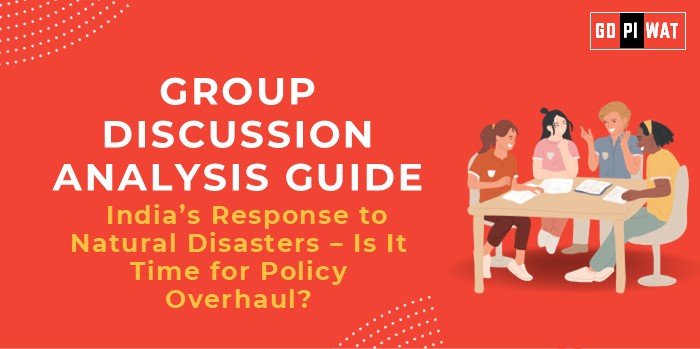📋 Group Discussion (GD) Analysis Guide
🌍 India’s Response to Natural Disasters – Is It Time for Policy Overhaul?
🌐 Introduction
India, one of the world’s most disaster-prone countries, faces recurrent natural disasters that strain its economy, infrastructure, and community resilience. With 22 of its 31 states highly vulnerable, the urgency for revisiting existing disaster policies is evident.
📊 Quick Facts & Key Statistics
- Global Disaster Ranking: India is among the top ten countries most affected by disasters globally, with 22 of 31 states particularly vulnerable.
- Economic Losses: Annual losses in India run into billions of dollars, affecting both infrastructure and livelihoods.
- Relief Fund Allocation: ₹1,60,153 crore allocated for the State Disaster Risk Management Fund (SDRMF) for 2021-26, with ₹1,28,122 crore for the State Disaster Response Fund (SDRF).
- Preparedness Gaps: Despite policies, challenges persist in early warning systems, infrastructure, and community awareness.
🧩 Stakeholders and Their Roles
- Government Agencies: Lead disaster preparedness and response coordination.
- Community Groups: Vital for implementing ground-level disaster awareness.
- Private Sector: Supports through CSR and logistics.
- International Bodies: Offer funds and technical expertise.
🏗 Achievements and Challenges
🏆 Achievements:
- Institutional Framework: NDMA and SDMAs ensure governance and policy compliance.
- Reduced Cyclone Mortality: Early warning systems have drastically cut cyclone-related deaths.
- Policy Allocations: Increased funds via the SDRMF and SDRF for disaster mitigation.
⚠️ Challenges:
- Infrastructure Gaps: Inadequate flood control and shelter facilities.
- Preparedness Shortcomings: Limited community involvement and awareness programs.
- Economic Strain: Substantial disaster recovery costs drain public funds.
🌏 Global Comparisons:
- Japan: Resilient infrastructure and precise disaster forecasting systems.
- Indonesia: Effective community engagement in disaster management.
📚 Case Studies:
- Odisha Cyclone Model: Exemplifies successful early warning systems and evacuation strategies.
- 2023 Sikkim Floods: Highlighted deficiencies in dam management and flash flood response.
✨ Effective Discussion Approaches
- Opening Techniques:
- Refer to India’s economic losses and funding allocations for disaster management.
- Use contrasting data points, e.g., robust cyclone responses versus unaddressed flood challenges.
- Counter-Argument Handling:
- Acknowledge significant progress in certain areas.
- Present alternative solutions for gaps in execution.
🔍 Strategic Analysis of Strengths & Weaknesses
- Strengths: Institutional structures like NDMA, effective cyclone management.
- Weaknesses: Lack of community engagement, insufficient warning systems.
- Opportunities: Leverage technology for disaster mapping and response.
- Threats: Increasing climate-related disasters, urban sprawl.
💡 Structured Arguments for Discussion
- Supporting Stance: “India’s reduced disaster mortality rates demonstrate a well-functioning response mechanism.”
- Opposing Stance: “Disaster management policies remain inadequate for addressing systemic gaps in preparedness and infrastructure.”
- Balanced Perspective: “While India has made notable strides in disaster management, bridging policy gaps and enhancing infrastructure remain critical.”
📚 Connecting with B-School Applications
- Real-World Applications: Disaster risk frameworks can inform urban planning and sustainability projects.
- Sample Interview Questions:
- “How would you improve India’s disaster management policies?”
- “What role can the private sector play in disaster mitigation?”
- Insights for B-School Students: Understand governance challenges, resource allocation, and technological innovations.


